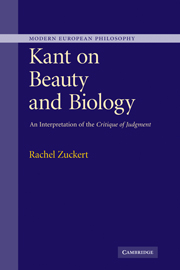Book contents
- Frontmatter
- Contents
- Acknowledgments
- Note on citations
- Introduction
- 1 The problem: The unity of the diverse
- 2 Reflective judgment and its principle: Preliminary remarks
- Part I Teleological judgment
- Part II Aesthetic judgment
- Introduction to Part II
- 5 Beautiful objects: Subjectively purposive form
- 6 Aesthetic pleasure: The feeling of subjective, projective temporality
- 7 The free harmony of the faculties: Purposiveness as the principle of aesthetic Beurteilung
- 8 The justification of aesthetic judgment: Purposiveness as the principle of reflective judging
- Conclusion
- Bibliography of works cited
- Index
7 - The free harmony of the faculties: Purposiveness as the principle of aesthetic Beurteilung
from Part II - Aesthetic judgment
Published online by Cambridge University Press: 22 September 2009
- Frontmatter
- Contents
- Acknowledgments
- Note on citations
- Introduction
- 1 The problem: The unity of the diverse
- 2 Reflective judgment and its principle: Preliminary remarks
- Part I Teleological judgment
- Part II Aesthetic judgment
- Introduction to Part II
- 5 Beautiful objects: Subjectively purposive form
- 6 Aesthetic pleasure: The feeling of subjective, projective temporality
- 7 The free harmony of the faculties: Purposiveness as the principle of aesthetic Beurteilung
- 8 The justification of aesthetic judgment: Purposiveness as the principle of reflective judging
- Conclusion
- Bibliography of works cited
- Index
Summary
In the previous two chapters, we have seen the ways in which purposiveness without a purpose is, according to Kant, the principle of beautiful objects and of aesthetic pleasure. In this chapter, I complete my interpretation of the ways in which this principle is constitutive of aesthetic experience on Kant's account. For here I turn to the way in which purposiveness is the principle of aesthetic judging (Beurteilung), or (that is) to Kant's account of aesthetic judging as the free harmony of the imagination and understanding in “free play,” as a “purposive state of mind” (v:296). I shall argue that purposiveness without a purpose characterizes the judging subject as the formal temporal structure of the activity of judging aesthetically: in aesthetic judging, we projectively, i.e., purposively without a purpose, synthesize heterogeneous sensible properties.
Aesthetic judging thus reunites the two components of purposiveness without a purpose that characterize beautiful objects and aesthetic pleasure, respectively – the unity of the diverse, and future-directedness. Indeed, aesthetic, purposive Beurteilung is, I shall argue, a necessary condition for the possibility both of representing objects as beautiful, and of aesthetic pleasure. Only if we can judge purposively without a purpose can we represent an object as beautiful, viz., as a unity of diversity formally purposive without a purpose (or without conceptual determination) (7.2–5). And only if we so judge can we take purely projective pleasure in such a representation.
- Type
- Chapter
- Information
- Kant on Beauty and BiologyAn Interpretation of the 'Critique of Judgment', pp. 279 - 320Publisher: Cambridge University PressPrint publication year: 2007
- 2
- Cited by



